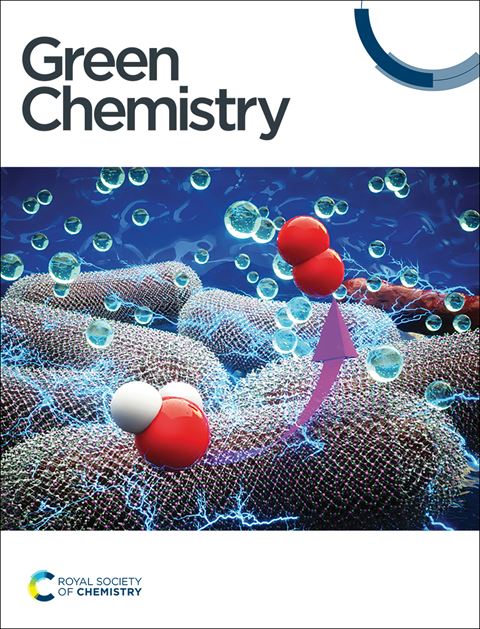Sonochemistry and sonocatalysis: current progress, existing limitations, and future opportunities in green and sustainable chemistry†
IF 9.3
1区 化学
Q1 CHEMISTRY, MULTIDISCIPLINARY
引用次数: 0
Abstract
Sonocatalysis is a specialised field within sonochemistry that leverages the interaction between ultrasound and solid catalysts to enhance the rate and selectivity of chemical reactions. As a non-traditional catalytic activation method, sonocatalysis can profoundly modify reaction mechanisms and unlock novel activation pathways that are not typically accessible through standard catalysis. This unique approach offers new opportunities for driving reactions under milder conditions while potentially improving selectivity and efficiency. This review highlights the recent progress of sonocatalytic applications in green chemistry and their contribution to the United Nations' Sustainable Development Goals (SDGs), including environmental remediation, sonotherapy, and biomass conversion. In these applications, we explore the underlying sonocatalytic mechanisms and the interaction between solid catalysts and ultrasound, which drive the enhanced reactivity. A key feature of this manuscript is its comprehensive analysis of the primary technical challenges in sonocatalysis, specifically its low energy efficiency and the complexity of reaction control. To address these hurdles, we examine various effective strategies, such as the incorporation of nanostructured catalytic cavitation agents and the design of advanced microfluidic sonoreactors. These innovations improve energy transfer, control bubble dynamics, and enhance catalytic activity under ultrasound. Furthermore, we implement molecular modelling to gain fundamental insights into the mechanisms fundamental to the effectiveness of sonocatalysts. This approach provides a deeper understanding of how nanostructured catalysts interact with ultrasonic fields, guiding the design of next-generation catalytic materials. The integration of nanostructured catalytic cavitation agents, microfluidic reactor technologies, and computational molecular modelling forms a trilateral synergistic platform that unlocks new potential in sonocatalysis. This multidisciplinary framework paves the way for significant advancements in green and sustainable chemistry, offering innovative solutions to global challenges in energy, health, and environmental sustainability.
声化学和声催化:目前的进展,现有的限制,和未来的机会在绿色和可持续化学†
超声催化是超声化学中的一个专业领域,它利用超声和固体催化剂之间的相互作用来提高化学反应的速度和选择性。作为一种非传统的催化活化方法,声催化可以深刻地改变反应机理,开启标准催化通常无法实现的新的活化途径。这种独特的方法为在较温和的条件下驱动反应提供了新的机会,同时有可能提高选择性和效率。本文综述了近年来声催化在绿色化学中的应用进展及其对联合国可持续发展目标(sdg)的贡献,包括环境修复、声疗法和生物质转化。在这些应用中,我们探索了潜在的声催化机制以及固体催化剂与超声波之间的相互作用,这些相互作用驱动了反应性的增强。这篇手稿的一个关键特点是它对声催化的主要技术挑战的全面分析,特别是它的低能量效率和反应控制的复杂性。为了解决这些障碍,我们研究了各种有效的策略,如纳米结构催化空化剂的结合和先进的微流控声反应器的设计。这些创新改善了能量传递,控制气泡动力学,并增强了超声催化活性。此外,我们实施分子建模,以获得对声催化剂有效性的基本机制的基本见解。这种方法提供了对纳米结构催化剂如何与超声场相互作用的更深入理解,指导下一代催化材料的设计。纳米结构催化空化剂、微流控反应器技术和计算分子模型的整合形成了一个三方协同平台,释放了声催化的新潜力。这个多学科框架为绿色和可持续化学的重大进步铺平了道路,为能源、健康和环境可持续性方面的全球挑战提供了创新的解决方案。
本文章由计算机程序翻译,如有差异,请以英文原文为准。
求助全文
约1分钟内获得全文
求助全文
来源期刊

Green Chemistry
化学-化学综合
CiteScore
16.10
自引率
7.10%
发文量
677
审稿时长
1.4 months
期刊介绍:
Green Chemistry is a journal that provides a unique forum for the publication of innovative research on the development of alternative green and sustainable technologies. The scope of Green Chemistry is based on the definition proposed by Anastas and Warner (Green Chemistry: Theory and Practice, P T Anastas and J C Warner, Oxford University Press, Oxford, 1998), which defines green chemistry as the utilisation of a set of principles that reduces or eliminates the use or generation of hazardous substances in the design, manufacture and application of chemical products. Green Chemistry aims to reduce the environmental impact of the chemical enterprise by developing a technology base that is inherently non-toxic to living things and the environment. The journal welcomes submissions on all aspects of research relating to this endeavor and publishes original and significant cutting-edge research that is likely to be of wide general appeal. For a work to be published, it must present a significant advance in green chemistry, including a comparison with existing methods and a demonstration of advantages over those methods.
 求助内容:
求助内容: 应助结果提醒方式:
应助结果提醒方式:


